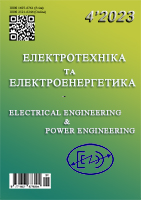Use of criteria for process optimization elevator complex routing
DOI:
https://doi.org/10.15588/1607-6761-2023-4-5Keywords:
minimization of the battle of grain products, minimum energy consumption, software-logic controller, logic equations, elevator complex, routing processAbstract
The goal of the work. The purpose of this work is to describe the optimality criteria for determining the direction of solving the problem of optimizing transport and technological routes of grain products at the elevator complex.
Research methods. An analytical research method was applied to determine the technological characteristics of the elevator complex line and the dependence of the quality of transported products on the constructed transportation route. A mathematical method is applied to describe the constituent elements of the optimization criteria.
Obtained results. One of the directions for increasing and improving the technological process at the elevator was determined, by improving the control algorithms in the direction of optimizing the technological processes of the elevator according to many criteria. According to optimization criteria, to ensure optimal transportation conditions, minimum losses, minimum transportation time, minimum energy consumption, and minimum length of the laid transportation path should be used, therefore, a description of the main criteria that can primarily affect the efficiency of the elevator complex was performed.
Scientific news. The direction of solving the problem of optimization of transport and technological routes is determined. Analytical derivation of the minimum energy consumption criterion and the minimum grain fight criterion.
Practical value. Optimization of the elevator complex to ensure variable transportation of grain masses, which will affect the productivity and quality of the technological process of the elevator complex.
References
Захарченко, Р. (2019). Р.В. Автоматизована система керування процесом сушіння зернових культур [Автореф. кандидатская работа].
О. В. Просяник, М. О. Просяник & С. М. Ткаченко. (2012). Перспективні напрямки розвитку автоматизованих систем на підприємствах зберігання та переробки зерна. Збірник наукових праць Національного гірничого університету, (39), 128–136.
Люлько, Ю. (2016b). Проблеми та перспективи розвитку хлібоприймальних підприємств та елеваторів. Зернові продукти і комбікорми, 2(18), 12–15.
Кудряшов, В. С. (2018). Решение задач автоматизации елеваторного комплекса. Вісник ВГУІТ, (11), 117–123.
Тимчук, С., Сиротенко, М., & Мардзявко, В. (2021). Підвищення ефективності технологічного процесу елеваторного комплексу за рахунок оптимальної маршрутизації. Інженерія природокористування, 22(4), 82–88.
Мардзявко, В. (2021). Аналіз методу маршрутизації транспортно-технологічних ліній переміщення зерна на елеваторах. У Молодь і сільськогосподарська техніка у ХХI сторіччі (с. 232–234). ХНТУСГ.
Спосіб підвищення енергоефективності роботи зернопереробних і зернозберігаючих комплексів (Патент України № 130996). (2019).
Просяник, А. В., & Ткаченко, С. (2014). Застосування SCADA-систем для керування технологічними маршрутами транспортування зерна. Хранение и переработка зерна, 130(4), 51–55.
Мардзявко, В., & Тимчук, С. (2021b). Шляхи підвищення якості зерна за рахунок умов транспортування. У Комп’ютерно-інтегровані технології автоматизації технологічних процесів на транспорті та у виробництві (с. 81–84).
Т. П. Фесун. (2021). Елеваторна промисловість: традиції та інновації. Вітчизняний та світовий досвід. Нац. ун-т харч. технол.
Downloads
Published
How to Cite
Issue
Section
License
Copyright (c) 2024 M.P. Kundenko, V.A. Mardziavko, A.Yu Rudenko

This work is licensed under a Creative Commons Attribution-ShareAlike 4.0 International License.
Creative Commons Licensing Notifications in the Copyright Notices
Authors who publish with this journal agree to the following terms:
Authors retain copyright and grant the journal right of first publication with the work simultaneously licensed under aCreative Commons Attribution License that allows others to share the work with an acknowledgement of the work's authorship and initial publication in this journal.
Authors are able to enter into separate, additional contractual arrangements for the non-exclusive distribution of the journal's published version of the work (e.g., post it to an institutional repository or publish it in a book), with an acknowledgement of its initial publication in this journal.
Authors are permitted and encouraged to post their work online (e.g., in institutional repositories or on their website) prior to and during the submission process, as it can lead to productive exchanges, as well as earlier and greater citation of published work.

